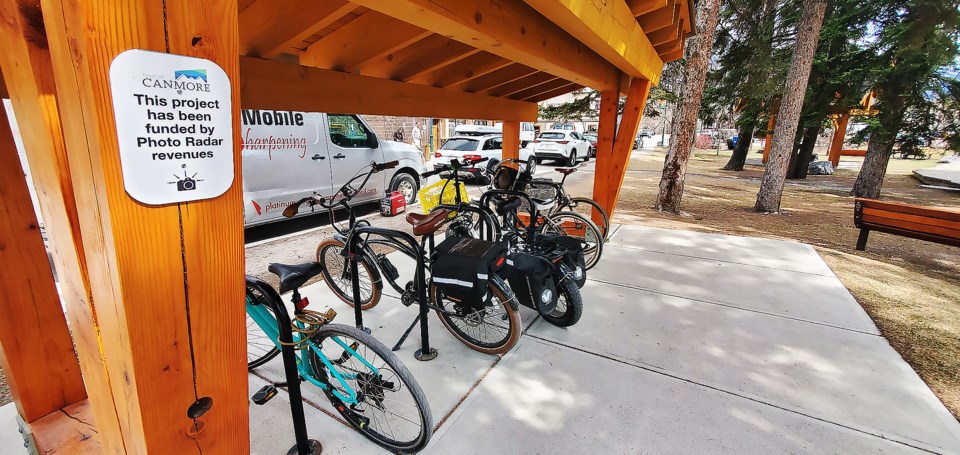CANMORE – A significant decrease in photo radar tickets – with the bulk going to non-Canmore residents – has seen revenue significantly cut during 2023.
The annual photo radar report showed the gross revenue for 2023 was $301,680, ending with $155,977 in net revenue for the year, which goes to policing and traffic safety costs. The net revenue was a large drop after coming in at $256,000 in 2022.
“With the provincial regulations that came into force December 2022, with the new signage that’s been on the [photo radar] vehicle … it’s been very effective in alerting people the vehicle is operating in an area, so people are slowing down,” said Caitlin Miller, the Town’s manager of protective services at the March 19 committee of the whole meeting.
“It’s serving as a pretty good public education piece of signage, which is what it’s intended to do in the provincial guidelines.”
She noted that with the Town having transitioned to 30km/h speed limits across residential areas, it’s led to people driving slower throughout the community.
According to the annual photo radar report, fine revenue went to fund 1.5 police officers for the Canmore RCMP and 41 new driver rebates at $250 each were awarded.
Traffic initiatives saw speed studies and bringing in 30km/h for all residential zones, two more traffic control speed signs, additional signage for pathway and trail etiquette and extra traffic calming islands.
At budget deliberations last year, Town staff warned council of continuing to rely on the photo radar reserve for funding RCMP positions. The reserve was anticipated to dry up by the end of 2025, meaning the positions would have to be covered by taxes.
The Town is set to undergo a long-term financial strategy this year, which would examine Town-wide financials.
Last year saw 6,617 instances of breaking the speed limit and 4,112 tickets were issued. The highest month was December with 414 tickets and the lowest was February with 265.
The bulk of the tickets – 84.5 per cent – were to non-Canmore residents.
It marks a roughly 60 per cent drop in tickets to 7,039 in 2022 from 8,916 in 2021.
“The message is getting out for residents that photo radar is here, what it looks like and they understand the drive safe vehicle is operating speed enforcement,” Miller said, noting an audit of the program took place last year and the Town is still waiting on results. “I think that education can continue. We’ve made sure we’ve gone through the appropriate signage at all entrances in town that photo radar is operating there.”
Miller noted vehicle signage can change depending on the municipality, with larger population centres such as Calgary and Edmonton often owning their own vehicles. In Canmore’s case, it operates 24 hours a week and the contractor would use the vehicle for other purposes.
Council, however, could increase the hours and purchase a vehicle if it chose to.
In 2023, photo radar ran for 1,301 hours and 40 per cent of that time was in playground and school zones. The remaining time was in other areas of the community.
“We’re seeing increased compliance in all of our playground and school zones, which is really great,” Miller said.
According to collision data provided by the province, there were 10 reported collisions in photo radar zones last year, with one resulting in an injury. Of those, nine were in 50km/h zones that are only on main arterial roads.
Since 2019, the number of collisions has ranged from a low of five in 2022 to a high of 12 in 2021 for a total of 45 in that time. There were nine injury-related collisions, including three with pedestrians.
The photo radar zones along Bow Valley Trail and Benchlands Trail have the highest number of collisions, according to the report. Twenty-seven of the 45 collisions have taken place along Bow Valley Trail at or near Ray McBride Drive and Benchlands Trail at or near Cougar Creek Drive.
Andy Esarte, the Town’s manager of engineering said, as Bow Valley Trail is being developed with more visitor accommodations and pathways added more crossing improvements will also come. He said it would slow some of that area down to serve as traffic mitigation in addition to moving pedestrians safely.
He added Benchlands Trail is more difficult since there are steep grades, the lanes become wider and it serves as an interchange. The stretch of road was also rehabilitated four years ago and there are no projects for the roadway in the near future where traffic calming measures could be added.
While overall traffic has continued to increase as Canmore grows and more people visit, Esarte said vehicle traffic is largely flattening with more people using active modes of transit and the same or declining number of vehicle collisions.
“From 2019-23, overall travel was up about 20 per cent but during that time there was actually a decrease in the number of collisions. … We’re seeing increased travel, decreased overall collisions and generally a trend towards less injuries, which suggest lower speeds and lower impact collisions,” he said. “We’re on the right trend and we’re keeping a close eye.”




